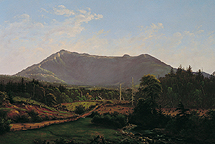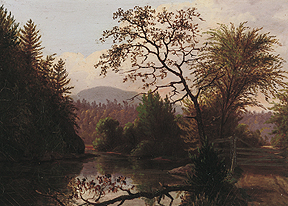

| SEARCH |
| UVM A TO Z |
| WHITE PAGES |
| UVM HOME |

(above) Pasage (sic) of the Otter Creek, Belden Falls
A view from the past
Cloud and Sunshine, Time and Season: UVM’s Fleming Museum celebrates the Vermont Landscapes of Charles Louis Heyde
In 1852, painter Charles Louis Heyde traveled north from his home in Brooklyn, New York, to southern Vermont for a season of painting. At thirty years old, Heyde was no novice. His landscapes — which were painted in the Hudson River School tradition — already had been exhibited at the National Academy of Design in New York, the Pennsylvania Academy of the Fine Arts in Philadelphia, and the Boston Athenaeum.
Like other Hudson River School painters, Heyde took his inspiration from the broad forms of nature, demanding that his paintings be life-like; that nature appear beautiful and inspiring, and that the picture present the moral elements of bucolic simplicity and virtue. His work caught the attention of poet Walt Whitman, which led to a lifelong relationship between the two artists. While visiting Whitman in Brooklyn, Heyde met the poet’s sister, Hannah, whom he married in April of 1852.
For the next four years, Heyde painted scenes in the southern part of Vermont and in the Connecticut River Valley—on the Battenkill at Arlington, at Saxtons River, on the Black River near Ludlow, at Rutland and Bellows Falls, near Brooksville on Otter Creek, near Brattleboro, and Greenfield, Massachusetts. Whether it is the light and shadows on the rocks along Saxtons River or the fishing scene on the Battenkill, the landscapes of this period stand out as some of his best paintings. After each season of painting, Heyde sold a few works in the area and then returned to Brooklyn to complete the other paintings and exhibit them.
In 1856, he decided to make Vermont his home. Heyde’s move to Burlington began a decade full of promise, with inspiring landscapes and ambition coupled with benefactors who welcomed new talent. In the small northern New England town, which had a population of 7,585, the cultural elite were eager to expand the community’s reputation for sophistication already established by the presence of the University of Vermont. George Grenville Benedict, the editor of The Daily Free Press, recognized that encouraging patronage for an artist would benefit both the artist and the newspaper. His squib in the Press on April 12, 1856 alerted readers to the fact that a newly arrived artist had located his studio at the corner of Water (now Battery) and Maple streets, in the Rutland and Burlington Railroad depot, and that his landscapes were worthy of attention. Over the years, Benedict’s attention to the arts kept Heyde and his paintings before the public’s notice.
 (left) Camel's Hump in Winter
(left) Camel's Hump in Winter
In 1864, city clerk James R. Hickok described Heyde’s studio, then located at 152 Church Street: “Enter the fine building on Church Street called Allen’s Block, ascend the stairway and pass to the extremity of the long narrow passage where a sign points to a door on the left labeled ‘Studio’…The ceiling, or sky, as the artist himself designates it, is painted a certain shade of blue; a green paper tones the wall; the floor is of the hue of near seas….” Hickok wrote that “Heyde paints that he may live,” explaining that the artist’s circumstances bound him to the necessity of executing small “cabinet pictures” that brought him a quicker dollar return.
In the boom of the post-Civil War economy, Burlington was the third largest lumber mart in the country. Newly affluent Vermonters, who were profiting from lumber interests and expanding transportation routes on water and land, together with transient lumber businessmen, brought lively sales of Heyde’s art. He exhibited paintings in quasi-public areas such as local hotel lobbies, City Hall, and local stores. Visitors responded and sought out his work.
 (right) Cave Island
(right) Cave Island
Heyde painted three subjects over and over, in summer, winter, and autumn: Mt. Mansfield, the High Bridge over the Winooski River, and Lake Champlain from Burlington. These scenes, with variations, were the mainstay of his oeuvre and were dependable sellers although the quality deteriorated over the years. Heyde chose to ignore the changes in the Vermont landscape, turning his back on the lakefront activity and the railroad — “the machine in the garden” — and the burgeoning industrial growth outside his studio door. His focus was on a farther, romantic landscape. Only when commissioned to paint a specific scene did he compromise this ideal.
Of his art, Heyde wrote: “Nothing can exceed the wild bold natural beauty of this place at present. The hues are incomparable, and the artist who is in his studio imagines himself a creator or interpreter of nature and her glorious beauties, here finds himself humbled and prostrate,…yet his study is a noble one, and the impression may serve when his time has past (sic) away.”
(below) Mount Mansfield, circa 1857
 In 1866, Heyde began to teach drawing at the Burlington Female
Seminary to supplement his income. The curriculum offered young
women drawing and painting classes in watercolor and oil. For
a course of twenty-four lessons Heyde received ten dollars per
pupil. Outdoor lessons, sketching from nature, cost more and were
a departure from the copying techniques Heyde normally taught
in the classroom.
In 1866, Heyde began to teach drawing at the Burlington Female
Seminary to supplement his income. The curriculum offered young
women drawing and painting classes in watercolor and oil. For
a course of twenty-four lessons Heyde received ten dollars per
pupil. Outdoor lessons, sketching from nature, cost more and were
a departure from the copying techniques Heyde normally taught
in the classroom.
Financial hard times caused Heyde to supplement his income by coloring landscape and portrait photographs for two Church Street photographers, A.G. Styles and L. G. Burnham. Competition from photographers, with their quickly available images, had seriously cut into the livelihood of artists, and Heyde must have found this adaptation of his skills a bitter pill to swallow. Some clues to his change in artistic mode come from Styles’s advertisements touting that he offered likenesses in oil or India ink.
The coup of Heyde’s career was winning the commission in 1862 to redesign the State of Vermont coat-of-arms, a competition sponsored by the Vermont Historical Society. The prize was $50 and the design, which was little more than a rearrangement of motifs lifted from the former coat-of-arms, was hung in its permanent location in the Secretary of State’s office in Montpelier. Subsequently, the original painting disappeared. It was replaced in 1895 with a copy by artist, W.C. Stacy. Later in 1884-1885, the committee in charge of the Vermont exhibits at the International Exposition and Cotton Centennial in New Orleans invited Heyde to participate. Such an honor suggests that the artist, well past his prime, was still considered an important interpreter of Vermont.
 (right) Lake Champlain and Rock Point, circa 1858
(right) Lake Champlain and Rock Point, circa 1858
After settling in Burlington, Heyde rarely painted outside the state, only once traveling to Canada in 1862 to paint in the Ottawa, Ontario region. The genre painting, “Devil’s Chute,” represents the strongest of his known Canadian works. The Adirondacks, an easy trip across Lake Champlain, lured Heyde three times. On the last outing in 1882 he painted “Whiteface Mountain.”
In 1865, Heyde purchased a house at 21 Pearl Street, consolidating his living space with a studio on the second floor. The sign outside proclaimed, “C.L. Heyde, Painter of Vermont Scenery.” That close living and working conditions strained the relationship between the neurotic temperaments of Hannah and Heyde is evidenced in letters to the family; the home became the scene of vituperative rantings by the artist against Hannah and the Whitman family and insults about the poet Walt Whitman’s published works. Though alienated by the artist, an alarmed Mother Whitman and Walt visited the tense household—Mother Whitman in 1865, and Walt in 1872, after delivering a commencement oration at Dartmouth College in Hanover, New Hampshire. Brother George and his wife visited in 1890.
As alcohol exacerbated the situation, the artist became more desperate and unkempt, setting out with unframed, hastily painted work under his arm and trading it for coal or food. Walt and George Whitman sent small handouts as Heyde’s health deteriorated.
He died at the Vermont State Asylum in Waterbury of chronic dementia on November 3, 1892. His grave was unmarked in Burlington’s Lakeview Cemetery until 1987 when the Chittenden County Historical Society placed a stone to honor the artist. Hannah survived until 1908. The Heydes were childless.
( below) View on Saxon (sic) River, Vermont circa 1855
below) View on Saxon (sic) River, Vermont circa 1855
Many of the scenes that Heyde painted have been inexorably changed over the last 150 years. A few survive, still pastoral scenes of charm and beauty, and maintain their ability to claim our affection. The pastoral landscape on which Heyde cast a romantic eye has come to be viewed in the twenty-first century as a national icon of Arcadia. Those fortunate enough to own a Heyde painting can claim a small piece of this Arcadia for their own. For the rest, there is the landscape itself. We all own it. The ultimate masterpiece is there before our eyes, if only in smaller and smaller frames, for us to glimpse as we hurtle along the paved highways of the twenty-first century, further and further from Heyde’s bucolic Eden. VQ
The University of Vermont’s Robert Hull Fleming Museum has mounted a comprehensive collection of more than fifty-five Charles Louis Heyde paintings. Eleazer Durfee ’86 and Thomas Pierce are guest curators for the Heyde exhibit: Old Summits, Far Surrounding Vales — The Vermont Landscapes of Charles Louis Heyde, (1822-1892), which is on display through June 2001. A catalog, Charles Louis Heyde, 19th Century Vermont Landscape Painter, accompanies the exhibit.
 (left) Saxton (sic) River, Vermont circa 1855
(left) Saxton (sic) River, Vermont circa 1855
Barbara Knapp Hamblett’s ’69 commitment to a career in the museum field began when she “discovered” Heyde during a UVM summer school course at the Shelburne Museum. He was the subject of her master’s thesis, now in the university’s Bailey-Howe Library, Special Collections. Her special thanks go to Thomas Pierce who helped locate and identify more than 150 of Heyde’s paintings.
by Barbara Knapp Hamblett '69